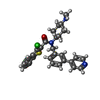登録情報 データベース : EMDB / ID : EMD-22119タイトル Structure of human SMO-Gi complex with SAG Structure of human SMO-Gi complex 複合体 : hSMO-Gi-SAG複合体 : hSMO複合体 : Gi複合体 : scFv16タンパク質・ペプチド : Guanine nucleotide-binding protein G(i) subunit alpha-1タンパク質・ペプチド : Guanine nucleotide-binding protein G(I)/G(S)/G(T) subunit beta-1タンパク質・ペプチド : Guanine nucleotide-binding protein G(I)/G(S)/G(O) subunit gamma-2タンパク質・ペプチド : Smoothened homologリガンド : 3-chloro-N-[trans-4-(methylamino)cyclohexyl]-N-{[3-(pyridin-4-yl)phenyl]methyl}-1-benzothiophene-2-carboxamideリガンド : CHOLESTEROL機能・相同性 分子機能 ドメイン・相同性 構成要素
/ / / / / / / / / / / / / / / / / / / / / / / / / / / / / / / / / / / / / / / / / / / / / / / / / / / / / / / / / / / / / / / / / / / / / / / / / / / / / / / / / / / / / / / / / / / / / / / / / / / / / / / / / / / / / / / / / / / / / / / / / / / / / / / / / / / / / / / / / / / / / / / / / / / / / / / / / / / / / / 生物種 Homo sapiens (ヒト) / Mus musculus (ハツカネズミ)手法 / / 解像度 : 3.96 Å Qi X / Li X ジャーナル : Nat Chem Biol / 年 : 2020タイトル : Sterols in an intramolecular channel of Smoothened mediate Hedgehog signaling.著者 : Xiaofeng Qi / Lucas Friedberg / Ryan De Bose-Boyd / Tao Long / Xiaochun Li / 要旨 : Smoothened (SMO), a class Frizzled G protein-coupled receptor (class F GPCR), transduces the Hedgehog signal across the cell membrane. Sterols can bind to its extracellular cysteine-rich domain ... Smoothened (SMO), a class Frizzled G protein-coupled receptor (class F GPCR), transduces the Hedgehog signal across the cell membrane. Sterols can bind to its extracellular cysteine-rich domain (CRD) and to several sites in the seven transmembrane helices (7-TMs) of SMO. However, the mechanism by which sterols regulate SMO via multiple sites is unknown. Here we determined the structures of SMO-G complexes bound to the synthetic SMO agonist (SAG) and to 24(S),25-epoxycholesterol (24(S),25-EC). A novel sterol-binding site in the extracellular extension of TM6 was revealed to connect other sites in 7-TMs and CRD, forming an intramolecular sterol channel from the middle side of 7-TMs to CRD. Additional structures of two gain-of-function variants, SMO and SMO, showed that blocking the channel at its midpoints allows sterols to occupy the binding sites in 7-TMs, thereby activating SMO. These data indicate that sterol transport through the core of SMO is a major regulator of SMO-mediated signaling. 履歴 登録 2020年6月6日 - ヘッダ(付随情報) 公開 2020年9月30日 - マップ公開 2020年9月30日 - 更新 2020年11月25日 - 現状 2020年11月25日 処理サイト : RCSB / 状態 : 公開
すべて表示 表示を減らす
 データを開く
データを開く 基本情報
基本情報 マップデータ
マップデータ 試料
試料 機能・相同性情報
機能・相同性情報 Homo sapiens (ヒト) /
Homo sapiens (ヒト) / 
 データ登録者
データ登録者 引用
引用 ジャーナル: Nat Chem Biol / 年: 2020
ジャーナル: Nat Chem Biol / 年: 2020
 構造の表示
構造の表示 ムービービューア
ムービービューア SurfView
SurfView Molmil
Molmil Jmol/JSmol
Jmol/JSmol ダウンロードとリンク
ダウンロードとリンク emd_22119.map.gz
emd_22119.map.gz EMDBマップデータ形式
EMDBマップデータ形式 emd-22119-v30.xml
emd-22119-v30.xml emd-22119.xml
emd-22119.xml EMDBヘッダ
EMDBヘッダ emd_22119.png
emd_22119.png emd_22119_msk_1.map
emd_22119_msk_1.map マスクマップ
マスクマップ emd_22119_half_map_1.map.gz
emd_22119_half_map_1.map.gz emd_22119_half_map_2.map.gz
emd_22119_half_map_2.map.gz http://ftp.pdbj.org/pub/emdb/structures/EMD-22119
http://ftp.pdbj.org/pub/emdb/structures/EMD-22119 ftp://ftp.pdbj.org/pub/emdb/structures/EMD-22119
ftp://ftp.pdbj.org/pub/emdb/structures/EMD-22119 リンク
リンク EMDB (EBI/PDBe) /
EMDB (EBI/PDBe) /  EMDataResource
EMDataResource マップ
マップ ダウンロード / ファイル: emd_22119.map.gz / 形式: CCP4 / 大きさ: 178 MB / タイプ: IMAGE STORED AS FLOATING POINT NUMBER (4 BYTES)
ダウンロード / ファイル: emd_22119.map.gz / 形式: CCP4 / 大きさ: 178 MB / タイプ: IMAGE STORED AS FLOATING POINT NUMBER (4 BYTES) emd_22119_msk_1.map
emd_22119_msk_1.map 試料の構成要素
試料の構成要素 解析
解析 試料調製
試料調製 電子顕微鏡法
電子顕微鏡法 FIELD EMISSION GUN
FIELD EMISSION GUN
 画像解析
画像解析 ムービー
ムービー コントローラー
コントローラー











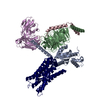
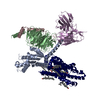



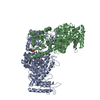
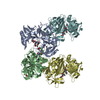

























 Z
Z Y
Y X
X

























 Trichoplusia ni (イラクサキンウワバ)
Trichoplusia ni (イラクサキンウワバ)